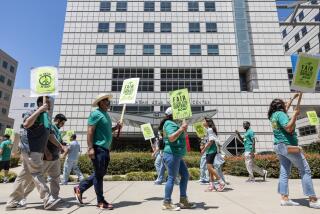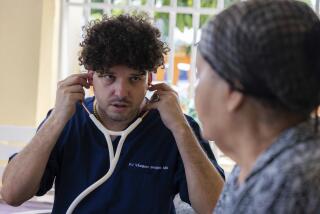Student-run free clinic helps fill a healthcare void
Reyna Paniagua, 25, and her son Diego Bahena, 3, are sitting in the sparsely decorated waiting room of an Orange County medical clinic. Diego plays with his mom’s hands. She is youthful and pretty, her hair pulled back tightly in a bun. In a few minutes, a man one year Paniagua’s senior will tell her she has hypothyroidism -- and that it’s manageable, but she’ll be on medication for the rest of her life.
A few rooms away, Patrick Ahearn, 23, a first-year medical student who wears thin, round wire-rimmed glasses like Harry Potter’s, is preparing a team of would-be doctors to greet patients.
“Let’s try and be as quick and efficient as possible so we can all get home and study for our tests,” he tells them.
The UC Irvine Outreach Clinic is where medical students meet real patients -- most of whom are uninsured, don’t speak English and haven’t seen a doctor in years.
Almost no one here is quite what he or she seems.
The handful of men and women walking around in white coats with stethoscopes around their necks? They’re students at UCI’s medical school, some of whom just finished their undergraduate studies and, as Ahearn said, spend most of their days studying for tests. Nurses in scrubs are nursing students; the young woman making appointments is a master’s student studying environmental toxicology.
But the services these students provide at their clinic, which opened in November and primarily serves low-wage patients from Santa Ana, are very real. Although the federal and state governments provide services or coverage for uninsured children, adults without insurance -- particularly undocumented adults -- are often left with minimal access to healthcare. Often, they resort to using emergency room visits for primary care.
Although the flagging economy has worsened the situation for those who struggle to get by, the students who run the clinic think that they are helping address a need that existed long before the government started laying off social services workers and ratcheting back programs.
The free clinic does business Saturdays from an existing low-cost clinic at the Village of Hope, a five-acre campus of low-cost medical facilities and dormitories for those who need shelter. The entire campus, though long in the planning, is relatively new and sits on a far edge of the former Tustin Marine base.
This is where the UCI clinic hopes to make a difference. By giving patients comprehensive healthcare -- which includes taking detailed medical histories, scheduling follow-up visits, providing necessary exams and free or reduced-cost medications -- the students think that they can make a dent in the number of people who resort to emergency care for preventable or treatable conditions.
For many of the student volunteers, this is a first shot at treating real patients as opposed to a rotating cast of paid actors who pretend to have myriad maladies for their benefit.
When told that they are expected to spend an hour with new patients, going over medical histories and getting detailed lifestyle descriptions, they are eager. When they’re quizzed by the doctor who oversees their work, they are excited.
On a recent Saturday, Dr. Emily Dow, the clinic’s medical director, joined John Shin, 26, a fourth-year medical student, in an exam room with Paniagua. She came to the clinic in January because she felt lethargic, cold and swollen. She has no insurance and before the visit she hadn’t seen a doctor in three years, when her son Diego was born. For most of that time, she imagined that her symptoms were lingering from pregnancy.
On the first visit, the clinic ordered and paid for a full work-up, which is how the students learned Paniagua had hypothyroidism. Paniagua’s face dropped when she learned she would have to be on medication for the rest of her life.
“It’s very treatable. You just need to take the medicine,” Dow told her, in fluent Spanish, ever the seasoned professional.
Then the doctor shifted into teaching mode with her student.
“Did you check her thyroid?” she asked Shin.
Shin: “I tried, but I couldn’t. . . . I wasn’t sure.”
Dow: “Her thyroid is definitely palpable.”
Shin craned his neck to take a look while Dow felt Paniagua’s throat.
Dow: “What are some of the other symptoms of hypothyroidism?”
Shin: “I can’t remember if it’s. . . . “
Dow fed him the answer: “A delayed reaction of reflexes?”
Shin followed Dow’s lead and tapped Paniagua’s knees to test her reflexes.
If there was a delayed reflex it was imperceptible. Shin looked to his mentor to hear what she had to say.
“It’s subtle,” Dow said. “But it’s there.”
Shin nodded, somewhat uncertain.
Behind him, Diego sat watching, his legs dangling from a low chair, a broad smile on his face as he watched teacher and student help his mom.
--
More to Read
Sign up for Essential California
The most important California stories and recommendations in your inbox every morning.
You may occasionally receive promotional content from the Los Angeles Times.











